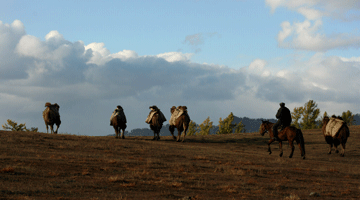Urumqi
Overview
-
As the capital city of Xinjiang Uyghur Autonomous Region, Urumqi is located in a green oasis between the lofty ice-capped Bogda Peak, the vast Salt Lake in the east, the rolling pine-covered Southern hill and the alternating fields and sand dunes of Zunggar Basin in the northwest. It is regarded as the most remote city from any sea in the world at a distance of about 1,400 miles from the nearest coastline. In history Urumqi was an important town on the northern route of the Silk Road, a vast network of trade routes that also facilitated cultural exchanges throughout Eurasia.
Highlights:
Exhibits of mummies and other artifacts of Uyghur ethnic culture and treasures from the Silk Road
The colorful culturally rich Urumqi Bazaar
The beautiful splendor of Heavenly Lake -Tianchi
Best Time to Visit?
-
May to October, when flowers are in full bloom, melons and fruits smell sweet and are ripe for picking.
How to get there?
-
Air

Beijing to Urumqi
There are around 21 flights daily from 07:00-21:00 (31/2 hours)
Urumqi to Beijing
There are around 14 flights daily from 08:00-20:00 (31/2 hours)
Shanghai to Urumqi
There are around 5 flights daily from 8:00-21:30 (5 hours)
Urumqi to Shanghai
There are around 5 flights daily from 8:30-20:30 (41/2 hours)Train:
Beijing to Urumuqi T69(18:44-10:50) approx: 40hours
Urumqi to Beijing T70(20:03-13:38) approx: 41 1/2hoursShanghai to Urumuqi T52(20:48-15:17) approx: 42 1/2 hours
Urumqi to Shanghai T51(18:57-14:49) approx: 44 hours
What to see?
-
Red Hill (Hong Shan)
Red Hill is a symbol of Urumqi, owing to its uniqueness. The body of the mountain, made up of aubergine rock, has a reddish brown color.The place has been developed into the beautiful Red Hill Park. Modern entertainment facilities and ethnic performances bring a fresh and lively atmosphere to the park.
Southern Mosque
An important historic heritage site located in the downtown of Urumqi, built in 1919 and subsequently renovated on three different occasions. The mosque accommodates 1,100 Moslems.The most eye-catching architectural features on the property are found in the minaret; the bathing pool; the guest reception hall and most impressive and exquisite of all, the prayer hall.
Tartar Mosque
Also known as the Yanghang Mosque, located at the southern end of Jiefang Nan Lu. Built with private donations from the Tartar Community, the mosque is unique in its use of traditional Tartar architecture. It features geometric carvings in wood and brick and an octagonal dome adorned with a crescent. The mosque is a main center for worship in Urumqi, covering an area of over 3000sqkm, it can accommodate up to 1000 people in its prayer hall.The mosque is open to tourists, including women, however you need get permission prior to entry.
Tianchi(Heaven Lake)
Situated in the Heavenly Tianshan range, 115 km northeast of Urumqi, Heaven Lake (Tianchi) is arguably one of the nicest spots in all of China. Covering 4.9sqkm, it's China's answer to Switzerland, with lakes, waterfall and alpine scenery. The crystal water, the pine trees covering the hillsides and the snow capped mountains in the background make is a spectacular sight.This lake sits halfway up the mountain range and offers excellent walking and horseriding with breathtaking views, which is particularly refreshing for those arriving in Urumqi from the barren deserts elsewhere in Xinjiang.
Useful Information
-
It is offensive to shake water off your wet hands in public.
Protect yourselves against the elements in all seasons. Be careful about your drinking water. Boil it first.
Bring your camera as there are many very scenic spots in Urumqi.
Though the 'clock time' in Xinjiang is just the same as the rest of China, in fact there is a two hour difference in longitude between Urumqi and Beijing. For this reason the daily working hours are: 10:00 - 14:00, 15:30 - 19:30
While in Urumqi, you should modify you rest and dining times to be two hours later than if you were in a city in Middle China, otherwise you might feel out of step with local life. But don't forget that bus, train and flights all adopt Beijing Time. If you booked a flight to arrive or depart Urumqi at around 08:00, then you may find it is quite dark at that time. Please keep this in mind when making reservations.
More Information
-
People
According to the 2000 census, Ürümqi has 2,081,834 inhabitants with a population density of 174.53 inhabitants/km². Of these, 75.3% are Han Chinese, 12.8% are Uyghurs, 8.0% are Hui and 2.3% are Kazakhs and Kyrgyz.
Food
Urumqi's culinary culture is rich and unique, a nice break from your typical Chinese fare. Of course, you can still find lots of typical Chinese food including Sichuan and Cantonese cuisine, but the local ethnic food and snacks are very tasty and very hot! Uigur, Mongolian, and Hui minority cuisine will all make your mouth water!As both the Uigur and Hui minorities are Muslim, pork is rare in Xinjiang. Only Han Chinese eat pork here. It is therefore, important to remember to respect this tradition and remember that most meat served to you will either be mutton, beef, chicken or possibly duck. Xinjiang cuisine really excels at the preparation of mutton and Mutton Kebabs are popular throughout China. Other typical Xinjiang dishes include Lamian noodles, Nan bread, and Uigur rice
Souvenirs
Muslim woman weaving a silk carpet
Urumqi is a great place to pick up some interesting craft items like ethnic clothing, embroidery, and jewelry. Other handicrafts include jade carvings, Kashgar carpets, exotic knives, wood crafts, and ethnic musical instruments.
As a province, Xinjiang is famous for its fruit including; grapes, hami melon, almonds, pomegranates, figs, peaches, apples and much more.


 The Silk Road (Dunhuang, Kashgar & Kazakh)
The Silk Road (Dunhuang, Kashgar & Kazakh) In-depth Silk Road Journey (Xinjiang's Kashgar, Kucha and Takalamakan Desert)
In-depth Silk Road Journey (Xinjiang's Kashgar, Kucha and Takalamakan Desert) North Xinjiang's Kanas Lake,Hemu Village & Narati Grassland
North Xinjiang's Kanas Lake,Hemu Village & Narati Grassland 



